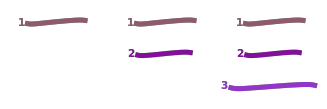
This page gives a few generalities about how to write kanji in the correct stroke order. The stroke order given here is specifically the Japanese one. Chinese orderings may differ in some details.
To find the stroke order of a particular kanji, refer to Kanji stroke order diagrams at sljfaq.org.
The basic rule of kanji stroke order is "go from top to bottom and left to right".
In 三, each stroke is written from left to right ⇶, starting with the uppermost stroke.

In 川, each stroke is written top to bottom, with the left strokes written before the right strokes.
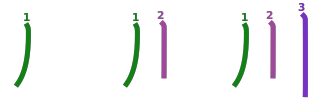
When horizontal and vertical strokes cross, horizontal strokes are usually written before vertical strokes, as in 十.
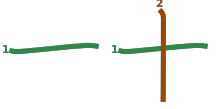
The character 田 (rice field), which also occurs in 魚 (fish) is an exception to this rule.

Vertical strokes that pass through many other strokes are written after the strokes through which they pass, as in 中 or 用.


Horizontal strokes that pass through many other strokes are written last, as in 母 or 舟.


Right-to-left diagonals are written before left-to-right diagonals:

In characters with a longer central vertical, like 水 or 糸, the vertical is written before the shorter components on the left and right. Then components on the left of the vertical are written before components on the right.


Left vertical strokes are written before across and down strokes, as in 口 or 門.
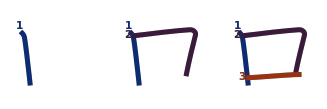

Outside frames are written before insides in kanji like 病, but bottom strokes in the enclosure are written last if present, as in 回.


Some enclosing components with a bottom part, known as 繞, are written last, as in the shinnyō in 近 or ennyō of 建.


However, some other enclosing components are written first, as in 起.

Dashes are often written last, as in 求:

The two first strokes of the kanji for "left" 左 and "right" 右 are written oppositely.


This mnemonic may be useful to remember the order: If you think of "migi" as your right arm and hand holding a box or O shape, and "hidari" as your left arm and hand holding a girder or rotated H shape, the "hand" of migi is the down and left stroke, and the "hand" of hidari is the across stroke, and in both cases the "hand" is written before the "arm".
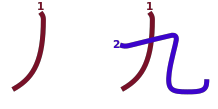
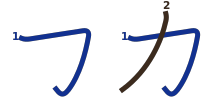
If you think of the two strokes as forming part of one movement with a brush, the order makes a bit more sense.
A sloping horizontal stroke at the top, as in kanji like 私 or 重, usually goes from right to left.


The kanji illustrations on this page are taken from those of the KanjiVG project, copyright © Ulrich Apel, and are used under a Creative Commons Licence.
Copyright © 1994-2025 Ben Bullock
If you have questions, corrections, or comments, please contact Ben Bullock or use the discussion forum / Privacy policy

|

|

|

|

|
| Book reviews |
Convert Japanese numbers |
Handwritten kanji recognition |
Stroke order diagrams |
Convert Japanese units |